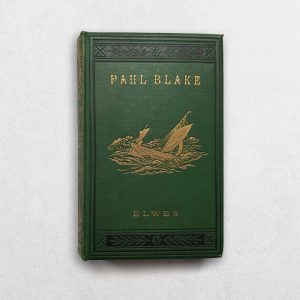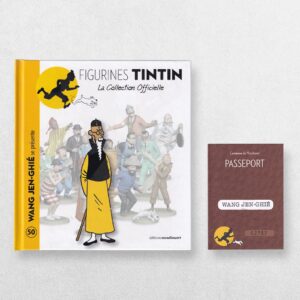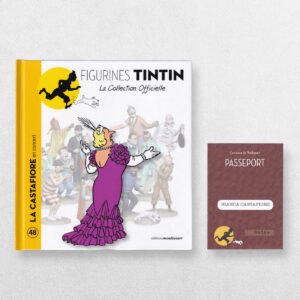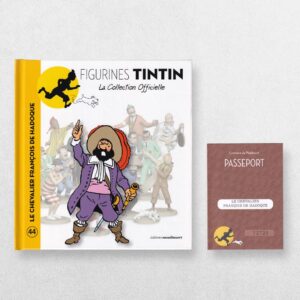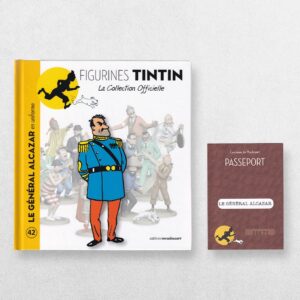Mr Cutts The Butcher On The Telephone – Figurines Tintin La Collection Officielle – 54 – Monsieur Sanzot Au Téléphone
Hergé & Editions Moulinsart
£65.00
Availability: In stock
Product Description
Mr Cutts The Butcher On The Telephone – Figurines Tintin La Collection Officielle – 54 – Monsieur Sanzot Au Téléphone
Author: Hergé & Editions Moulinsart
Price: £65.00
Publisher: Editions Moulinsart
Publication date: 2013
Format: Original pictorial boards with passport and figurine
Condition: In near fine condition
Illustrations: Illustrated throughout
Description:
Original pictorial boards. Includes passport loosely inserted. Text in French. Includes the accompanying figurine. One from the collection of 111 books and figurines. Very slight wear. In very near fine, clean condition overall.
Mr Cutts The Butcher: A Short Biography
Mr Cutts the Butcher is a minor but memorable recurring character in Hergé’s The Adventures of Tintin. Appearing chiefly in The Red Sea Sharks (Coke en stock, 1958) and referenced elsewhere, he embodies the comic realism of Tintin’s domestic world. Through him, Hergé added warmth, humour, and a touch of everyday life to balance the grand themes of adventure, politics, and morality that run through the series.
Character Overview
Mr Cutts (originally Monsieur Sanzot in French) is the local butcher who serves Marlinspike Hall, the home of Captain Haddock, Tintin, and Professor Calculus. He is an ordinary tradesman — good-natured, courteous, and completely unaware of the chaos his actions sometimes cause.
His English name, “Cutts,” cleverly plays on his profession while preserving the genial tone of the French original.
Although his appearances are brief, he has become an iconic part of Tintin’s domestic setting, representing the ordinary people who inhabit the world beyond Tintin’s adventures.
First Appearance and Role in The Red Sea Sharks
Mr Cutts’s most famous appearance occurs at the beginning of The Red Sea Sharks. The scene, though short, is one of the funniest in the entire series and a perfect example of Hergé’s mastery of timing and character interplay.
The episode begins when Captain Haddock receives a phone call at Marlinspike Hall. The conversation unfolds as follows:
“Hallo? Is that the butcher, Sanzot?”
“No, this is Marlinspike Hall!”
“Oh, I’m sorry — wrong number.”
Moments later, the phone rings again. Haddock answers, only to hear the same voice repeat:
“Hallo? Is that the butcher, Sanzot?”
This simple misunderstanding rapidly escalates into absurdity, with Haddock’s growing exasperation and the repetition of the wrong number creating one of the most memorable comedic beats in the series.
The joke works on multiple levels: it showcases Haddock’s short temper, highlights the intrusion of the mundane into the aristocratic calm of Marlinspike, and captures the rhythms of real-life miscommunication with perfect precision.
Though Mr Cutts himself never appears on the page during this exchange, his presence is immediately recognisable — the polite, slightly flustered tradesman, innocently causing mayhem from the other end of the line.
Personality and Traits
Even in absence, Mr Cutts’s personality is implied through tone and situation:
- Courteous: Always polite and businesslike, never rude even when confused.
- Ordinary and reliable: Represents the everyday world beyond Tintin’s adventures.
- Comically oblivious: His repeated calls, made in error, unintentionally provoke Captain Haddock’s volcanic temper.
He is a symbol of domestic normalcy — the butcher whose simple mistake punctures the grand world of Tintin’s high-stakes adventures.
Symbolism
Hergé often balanced Tintin’s global escapades with brief moments of homely, provincial life. Mr Cutts represents the ordinary citizen, grounding the heroes in a recognisable social reality.
- Comic Contrast: His mundane phone call contrasts sharply with the geopolitical intrigue of The Red Sea Sharks, creating a moment of levity before the plot turns serious.
- Social Authenticity: By including characters like Mr Cutts, Hergé humanises his world. Marlinspike Hall, though grand, remains connected to everyday life — the milkman, the butcher, the villagers.
- Universal Humour: The wrong-number joke transcends language and culture, showcasing Hergé’s ability to find comedy in small, relatable incidents.
Relationship with Captain Haddock
Mr Cutts’s inadvertent relationship with Captain Haddock is purely telephonic but profoundly comic. Haddock’s fiery temperament and Mr Cutts’s politeness form a perfect comic duo — two characters who never meet yet produce one of the funniest interactions in the series.
The misunderstanding also reveals Haddock’s character: beneath the bluster, he is lonely and easily flustered by domestic intrusion. Mr Cutts becomes, in effect, a foil through which Haddock’s humanity and humour shine.
Artistic and Narrative Importance
Though appearing in a single short sequence, the “Mr Cutts phone call” exemplifies Hergé’s genius for pacing, rhythm, and everyday observation. The gag works visually (through Haddock’s facial expressions), aurally (through the repeated phrase), and structurally (as a pause before the main narrative begins).
This domestic interlude — a scene of comic stillness before a storm of adventure — shows Hergé’s storytelling discipline. Even in a work dealing with slavery and international crime, he found space for ordinary laughter.
Legacy
Mr Cutts the Butcher remains one of Tintin’s most beloved minor characters. His brief but unforgettable scene has achieved almost legendary status among readers, illustrating Hergé’s mastery of character economy — the ability to create memorable personalities in just a few panels.
He also stands as a reminder that The Adventures of Tintin is not only about far-flung quests and moral dilemmas, but also about the humour, humanity, and imperfection of everyday life.
Summary
- Full name: Mr Cutts (originally Monsieur Sanzot)
- Occupation: Butcher
- First appearance: The Red Sea Sharks (Coke en stock, 1958)
- Traits: Polite, practical, ordinary, unintentionally comic
- Symbolism: Represents the humour and domestic realism that balance Tintin’s high adventure
- Notable moment: The mistaken telephone call scene at Marlinspike Hall
- Relationship: Indirectly comic foil to Captain Haddock
Conclusion
Mr Cutts the Butcher may be a minor figure in Hergé’s world, but he embodies the charm and warmth that make The Adventures of Tintin feel alive. In a few lines of dialogue, Hergé captured the texture of ordinary life — the humour of small mistakes and the universality of human misunderstanding.
Through Mr Cutts, the grandeur of Tintin’s universe becomes human-sized: a world where heroes, villains, and butchers coexist, and where even a wrong number can be unforgettable.
Why Buy from Us?
At Hornseys, we are committed to offering items that meet the highest standards of quality and authenticity. Our collection of objects and rare books are carefully curated to ensure each edition is a valuable piece of bibliographical history. Here’s what sets us apart:
- Authenticity and Provenance: Each item is meticulously researched and verified for authenticity and collation.
- Expert Curation: Our selection process focuses on significance, condition, and rarity, resulting in a collection that is both diverse and distinguished.
- Customer Satisfaction: We aim to provide an exceptional customer experience, from detailed descriptions to secure and prompt delivery of your purchase.
- Returns Policy: We offer an unconditional guarantee on every item. If you wish to return an item, it may be sent back to us within fourteen days of receipt. Please notify us in advance if you wish to do so. The item must be returned in the same condition as it was sent for a full refund.
Cataloguer: Daniel Hornsey
Daniel Hornsey has specialised in fine and rare books, ephemera, and collectors’ editions for over thirty years. As a long-standing member of the antiquarian book trade, he has advised private collectors, curated catalogues, and sourced works for leading dealers, libraries and institutions across the world.
Hornseys’ exhibit regularly at book and map fairs in London and throughout the UK and are members of the Provincial Booksellers Fairs Association, the PBFA.
His fascination with Hergé’s work — especially ‘The Adventures of Tintin’ — began in childhood. Daniel recalls reading Tintin in original European editions and quickly recognising that these were not merely children’s books, but finely illustrated narratives crafted with artistic depth and wit.
As noted by the Musée Hergé in Louvain-la-Neuve, Hergé’s ‘ligne claire’ style has influenced generations of European comic artists and his original drawings and paintings command very high prices with his painting of ‘The Blue Lotus’ jar fetching £2.8m at auction in 2021.
By presenting these works through Hornseys’, he hopes to contribute to the continued appreciation of one of the 20th century’s most influential illustrators, helping new generations discover the artistry and legacy of Hergé.
Related products
The Gruffalo & The Gruffalo’s Child: First Deluxe Miniature Editions Both Signed By Julia Donaldson & Axel Scheffler
£495.00Donaldson, Julia & Scheffler, Axel
Paul Blake Or The Story Of A Boy’s Perils In The Islands Of Corsica And Monte Cristo
£125.00Elwes, Alfred (Leighton Binding)
You may also like…
Mr Wang Introduces Himself – Figurines Tintin La Collection Officielle – 50 – Wang Jen-Ghie Se Présente
£60.00Hergé & Editions Moulinsart
Castafiore In Concert – Figurines Tintin La Collection Officielle – 48 – La Castafiore En Concert
£45.00Hergé & Editions Moulinsart
Sir Francis Haddock – Figurines Tintin La Collection Officielle – 44 – Le Chevalier François De Hadoque
£95.00Hergé & Editions Moulinsart
General Alcazar In Uniform – Figurines Tintin La Collection Officielle – 42 – Le Général Alcazar En Uniforme
£45.00Hergé & Editions Moulinsart
Colonel Sponsz Upset – Figurines Tintin La Collection Officielle – 37 – Le Colonel Sponsz Contrarié
£55.00Hergé & Editions Moulinsart
Monsieur Boullu The Stonemason – Figurines Tintin La Collection Officielle – 35 – Monsieur Boullu Le Marbrier
£40.00Hergé & Editions Moulinsart
Haddock Alpinist – Figurines Tintin La Collection Officielle – 34 – Haddock En Alpiniste
£45.00Hergé & Editions Moulinsart
Calculus The Gardener – Figurines Tintin La Collection Officielle – 28 – Tournesol En Jardinier
£35.00Hergé & Editions Moulinsart
Haddock As Hadoque – Figurines Tintin La Collection Officielle – 24 – Haddock En Hadoque
£45.00Hergé & Editions Moulinsart
Ridgewell The Explorer – Figurines Tintin La Collection Officielle – 23 – Ridgewell L’Explorateur
£45.00Hergé & Editions Moulinsart
Tintin In Kilt – Figurines Tintin La Collection Officielle – 22 – Tintin En Kilt
£65.00Hergé & Editions Moulinsart
King Muskar Puts On His Gloves – Figurines Tintin La Collection Officielle – 20 – Le Roi Muskar Enfile Ses Gants
£45.00Hergé & Editions Moulinsart
Snowy Stuck In The Crab Tin – Figurines Tintin La Collection Officielle – 19 – Milou Coincé Dans La Boîte De Crabe
£45.00Hergé & Editions Moulinsart
Nestor With The Tray – Figurines Tintin La Collection Officielle – 18 – Nestor Au Plateau
£45.00Hergé & Editions Moulinsart
Chang Points Out Hou Kou – Figurines Tintin La Collection Officielle – 8 – Tchang Indique Hou Kou
£35.00Hergé & Editions Moulinsart
Tintin In A Lunar Spacesuit – Figurines Tintin La Collection Officielle – 7 – Tintin En Scaphandre Lunaire
£55.00Hergé & Editions Moulinsart
Snowy Carries His Bone – Figurines Tintin La Collection Officielle – 6 – Milou Promène Son Os
£40.00Hergé & Editions Moulinsart
Castafiore With The Parrot – Figurines Tintin La Collection Officielle – 5 – La Castafiore Au Perroquet
£75.00Hergé & Editions Moulinsart
Thomson Looking Awkward – Figurines Tintin La Collection Officielle – 4 – Dupond Engoncé
£40.00Hergé & Editions Moulinsart
Professor Calculus With A Spade – Figurines Tintin La Collection Officielle – 3 – Tournesol A La Bêche
£40.00Hergé & Editions Moulinsart
Haddock Doubtful – Figurines Tintin La Collection Officielle – 2 – Haddock Dubitatif
£40.00Hergé & Editions Moulinsart
Tintin In Trenchcoat – Figurines Tintin La Collection Officielle – 1 – Tintin En Trench-Coat
£75.00Hergé & Editions Moulinsart






